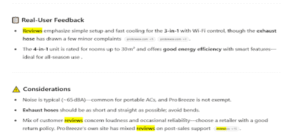Intro
Since the launch of SearchGPT – and more recently, native search features within ChatGPT – it’s clear that search has changed forever. For business owners, marketers and publishers, that’s a daunting realisation.
As someone who’s built an agency on simplifying the complex and delivering outcomes that truly matter to businesses, I don’t think the world needs another AI Search scaremongering post. That’s why in this article, I’m sharing my honest insights on how AI Search is reshaping SEO strategies – from the way we optimise to how we measure success.
Let’s get started exploring the impact of AI Search on SEO strategies.
Measuring performance and conversions
In traditional ‘blue link’ search, tracking users who click on your site from a specific keyword and convert into a lead or sale was relatively simple.
But today, over 58% of Google searches result in zero clicks (Search Engine Land) – a number that’s only expected to grow as AI search tools like ChatGPT and Perplexity gain popularity.
Add to that the fact that none of the major AI tools currently offer native analytics, and we’re left relying on third-party tools to understand how much visibility our content is getting in AI-driven search environments.
From traffic tracking to visibility monitoring
As AI Search becomes more widely used, businesses will need to shift from tracking just ‘clicks’, ‘traffic’, and ‘conversions’ to monitoring visibility.
That’s because AI-generated results often show fewer links – and when clicks do occur, they usually come without context (you won’t know what the user asked the AI to show your site). Because of this, the old model of attributing traffic to keyword intent starts to break down.
That’s why we believe SEO, as a marketing channel, must evolve to focus more on visibility and presence, not just traffic alone.
Adapting your tracking strategy
To get ahead and start gathering early data on your AI Search performance, here are two ways we recommend adapting your tracking stack:
- Referral tracking from AI search tools: Use Google Analytics to track referrals from tools like ChatGPT and Perplexity where possible. It’s simple to set up and gives you a baseline understanding of traffic sources.
- Visibility and query monitoring via third-party tools: We currently recommend Semrush for visibility monitoring. These tools can help surface trends in keyword and topic exposure, even when direct clicks aren’t happening.

Adding these into your performance mix will help you better understand the real-world impact AI Search is having on your SEO strategy, and how your potential customers are using AI to discover suppliers and solutions in your space.
Off-site Mentions & Reviews
Off-site SEO has always played a key role in improving rankings and driving traffic through traditional Google search. But with the rise of AI Search, it’s becoming even more important – in new ways.
AI Search engines are increasingly pulling from a broader range of sources when generating responses. That includes off-site content that references your brand, your products, or your services – not just your website.
In our own testing, we’ve seen tools like ChatGPT regularly reference product features, pros and cons, or customer sentiment based on third-party reviews – not just content from the client’s site. Review platforms like Trustpilot are now feeding directly into the way AI tools describe your business.
That’s why it’s worth rethinking your off-site SEO strategy with a new lens.
1. Brand-Centric Link Building & Digital PR
Getting featured on reputable, high-authority websites with mentions of your brand, key people, or expert insights increases your chances of being referenced in AI search results.
It’s not just the visibility; the actual content you contribute to off-site platforms is being crawled and surfaced in responses. That means your off-site content now plays just as critical a role in your SEO strategy as your on-site work.
2. Customer Reviews & Testimonials
AI Search tools are increasingly using customer reviews to build a more detailed picture of a product or business. These insights are then summarised and shared in responses – often without any need for a user to click through.
To stay ahead, it’s worth being more intentional about how you gather and manage your reviews:
- Diversify your review sources: Encourage reviews on multiple trusted platforms to give AI more data to work with.
- Implement Schema markup: Make sure on-site reviews are properly marked up using Review schema so search tools can understand and reference them.
- Ask smarter questions: When requesting reviews, prompt customers to talk about product features or service details that other buyers care about – the kind of content AI tools look for.
See below for a real-world example where third-party reviews are cited in an AI search result for air conditioning unit recommendations.

Enhancing Front-end Content
AI Search isn’t just changing SEO strategies – it’s also reshaping consumer behaviour.
(You can read more about this shift in my recent blog on AI Search & self-educating buyers.)
Today’s consumers (and the AI tools helping them) expect more useful, detailed content on the front-end of your website. That means fewer PDFs, fewer vague landing pages, and fewer answers locked inside your sales team’s heads.
AI tools rely on accessible, crawlable content to generate their responses. If your technical product specs or installation guides are only available as downloadable PDFs, they likely won’t be surfaced in AI Search results.
These documents often contain valuable details like energy ratings, dimensions, install steps, or comparison data; exactly the kind of information that helps AI tools evaluate and cite your business as a source.
Why Is This Important?
For B2B businesses, it’s clear that buyers are doing more of their research independently, often long before they speak to your sales team. That means the details that once lived inside pitch decks or sales calls now need to be available up front.
Information like how your service works, what the process looks like, and even indicative pricing should be easy to find on your website. With more people using AI Search tools to shortlist and compare suppliers, the businesses that make their knowledge public and accessible are the ones that will be surfaced, and considered.
What You Can Do
Here are a few high-impact areas to focus on bringing to the front-end of your site:
- Process Breakdowns, Pricing Insights & FAQs
If you’re a service-based business – like us at Brick – or a software company, it’s important to offer at least some indication of pricing, even if every quote is bespoke. Alongside this, both consumers and AI tools want to understand what it’s like to work with you: the steps involved, how onboarding works, and the answers to common questions about your service.
This kind of information should no longer be reserved for a sales call or demo. Making it clearly available on your website helps AI understand your offering – and helps buyers build trust earlier. - Product Specifications and Manuals
From our own research, we’ve found that the more clear, structured data points you provide, the more likely AI tools are to cite your content.
Details like running costs, electronics information, dimensions, and any ancillaries needed for installation are all highly useful to AI Search tools – especially when users are comparing your product against alternatives.
If this content is buried in a PDF or not available at all, you’re missing out on visibility. - Sales Team Insights
Run an internal audit of the questions your sales or support team answer regularly during customer conversations. Then, use this insight to inform content on your website.
Publishing those answers not only helps educate buyers and reduce friction – it also increases the chances of your site being referenced in AI Search responses.
AI Search is here
Whether your SEO strategy is ready or not, AI Search is here to stay. Its impact will vary depending on your industry, sector, or business model – but one thing is clear: SEO strategies now need to become even more customer-centric in terms of content, and more transparent in how you present and “sell” your products or services online.
At Brick, we’re already helping clients adapt to this next chapter of search. If you’re rethinking how your business shows up, or you’re not sure how these changes apply to you, feel free to get in touch; We’re here to help you stay ahead of the curve.




